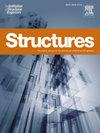A multiscale steel–concrete interface model for structural applications
IF 3.9
2区 工程技术
Q1 ENGINEERING, CIVIL
引用次数: 0
Abstract
In this paper, a new multiscale macro-element formulation for the steel–concrete interface modeling is proposed. This element allows for the representation of the behavior of steel and the interface zone surrounding it. It can also model the interfacial bond stresses in between. Compared to conventional interface models of the literature, which employ separate mesh elements for the steel and the interface, utilizing a macro-element to model both components simplifies the creation of a reinforced concrete structure mesh. Moreover, the macro-element equilibrium is solved using a sub-structuring method that aims to reduce the computational cost. At the global level, it is considered as a four-node element linked to two-dimensional and three-dimensional concrete elements. At the local level, an assembly of multiple three-node bar elements with bond stresses is performed. An inner mesh discretization is therefore possible at the local level independently of the global level. The coupling between the two modeling scales is done using a static condensation technique. The formulation of the macro-element is presented in this paper. A selection of numerical examples is provided. The presented applications demonstrate the robustness of the proposed interface model and its capacity to reproduce the experimental behavior of reinforced concrete structural elements.结构应用中的多尺度钢-混凝土界面模型
本文提出了一种用于钢-混凝土界面建模的新型多尺度宏观元素配方。该元素可表示钢材及其周围界面区的行为。它还可以对两者之间的界面粘结应力进行建模。与文献中为钢材和界面采用单独网格元素的传统界面模型相比,利用宏元素对这两个部分进行建模简化了钢筋混凝土结构网格的创建。此外,宏元素平衡采用子结构方法求解,旨在降低计算成本。在全局层面,它被视为与二维和三维混凝土元素相连的四节点元素。在局部层面上,将多个具有粘结应力的三节点条形元素进行组装。因此,在局部层面上可以独立于全局层面进行内部网格离散化。两种建模尺度之间的耦合是通过静态凝聚技术实现的。本文介绍了宏观元素的表述。本文还提供了一些数值示例。所介绍的应用证明了所提出的界面模型的稳健性及其再现钢筋混凝土结构元素实验行为的能力。
本文章由计算机程序翻译,如有差异,请以英文原文为准。
求助全文
约1分钟内获得全文
求助全文
来源期刊

Structures
Engineering-Architecture
CiteScore
5.70
自引率
17.10%
发文量
1187
期刊介绍:
Structures aims to publish internationally-leading research across the full breadth of structural engineering. Papers for Structures are particularly welcome in which high-quality research will benefit from wide readership of academics and practitioners such that not only high citation rates but also tangible industrial-related pathways to impact are achieved.
文献相关原料
| 公司名称 | 产品信息 | 采购帮参考价格 |
|---|
 求助内容:
求助内容: 应助结果提醒方式:
应助结果提醒方式:


